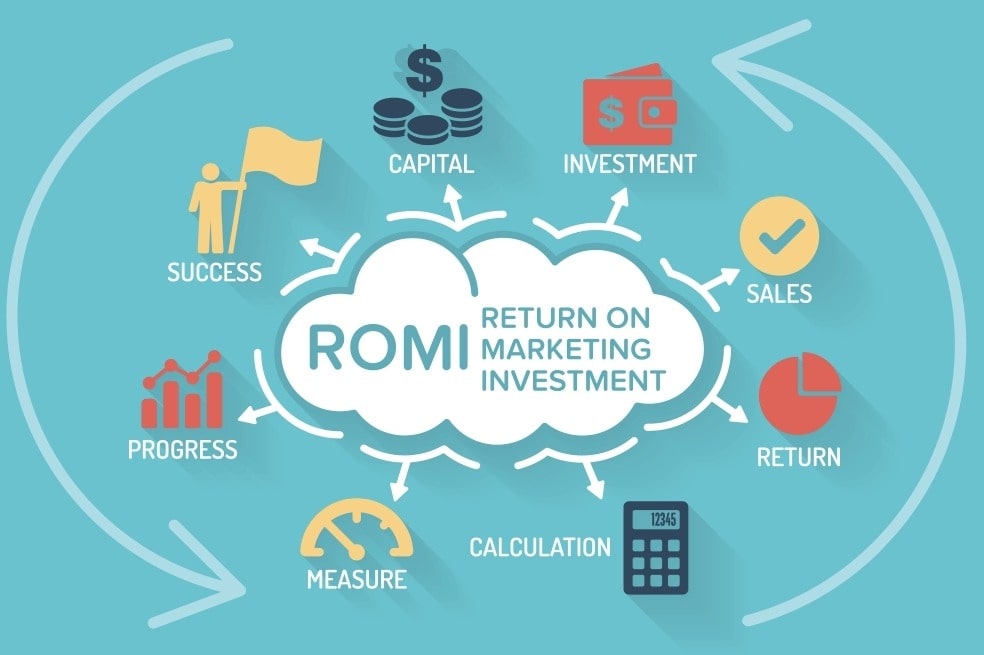What is Return On Marketing Investment? Important, Formula, Examples, Measuring and Managing
At the starting point of a new marketing campaign, every marketer should have a test system to know whether the project’s cost is benefiting or hurting the company. To determine profitability, many marketers look at ROI (Return On Investment). In general, ROI compares the amount of budget you spent on a project with the amount of revenue you gained from it.
But ROI was mainly created for a bigger picture of sales. For an advanced insight, I would like to introduce ROMI (Return On Marketing Investment) - a better way to measure a marketing campaign’s effectiveness. It will help you answer questions like: Was your budget well spent on marketing? Does your marketing campaign actually work? Do marketers have an efficient approach?
The strategy of measuring your return on marketing investment can be incredibly helpful for e-businesses as they learn which tactics are worth investing in and what not. In this article, let’s take a look at what you need to know about ROMI with examples and how you can apply your company’s method.
What is the Return on marketing investment?

ROMI or Return on marketing investment is a metric used to measure the effectiveness of a marketing campaign. By applying formulas, marketers can evaluate the performance, profit, and impact of the marketing effort. The insights gained by looking at the metric can help create future strategies with a data-driven approach for smarter decision making.
ROMI is a subcategory of ROI (Return on Investment) because here the cost is calculated for marketing only.
Effective marketers use ROMI to connect their time, energy, and marketing resources with results that contribute more to the company’s growth. Typically, ROMI can justify the marketing spend and budget allocation for future campaigns.
The importance of return on marketing investment
At the organizational level, calculating return on marketing investment can help guide future business decisions and optimize the marketing budget. For marketers, understanding the ROMI generated by campaigns brings these important benefits:
- Justify marketing spend: For most companies, marketing has a significant expense, and executives or leaders want to know if they are getting the best result from the budget. With the return on marketing investment, you can prove that marketing does have a positive impact on the profitability of the company. For example, if marketers can prove that the monthly revenue relies on the effectiveness of Facebook ads, they can ask for a bigger budget in the upcoming months.
- Allocate marketing budgets: ROMI is often calculated at the campaign or program level so marketers can know which efforts bring a higher return and therefore deserve more investment. Marketers can also predict future spending levels, budget across channels, and suitable messages for customers. For example, if your email marketing is driving a good conversion rate and ROI, while social media ads fall flat, you can more properly decide what to spend on.
- Keep marketers accountable: Good marketing is not about telling interesting stories with much creativity, it is always about delivering sales and customers. ROMI helps measure how efficiently a business is using its budget for marketing and keeps marketers accountable for using money wisely. For smaller teams or individual marketers, ROMI prompts them to focus and justify every dollar they spend on marketing.
- Compare with competitors: Tracking the ROMI of competitors shows how your company’s marketing effort is performing against other players in the industry. While it is usually not public information, you can look at published financial statements to estimate the competitors’ ROMI. Then, marketers can adjust baselines to reflect the estimation - keeping the marketing efforts consistently competitive with competitors.
Return on marketing investment Formula
There are several different ways to calculate the return on marketing investment, but before we get to that, let’s see some key terms that you should understand:
- Leads: new potential buyers generated by a marketing campaign
- Number of leads: The number of people converted into leads in a campaign
- Lead to customer rate: The percentage of leads that become customers. For example, If 19 out of 100 leads become a customer, you have a 19% or 0.19 lead to customer rate.
- Incremental sales: New revenue created by a marketing campaign
- Wins: New customers gained from a marketing campaign
- Average sales price: The average price you sell your products, which is helpful if you occasionally have discounts or alter pricing
- Marketing cost: How much you spent on creating and promoting your marketing campaign. Costs can be ad spend, hourly wages of employees, or content production costs, and more.
To calculate your return on marketing investment, here is the simplest formula:
The formula is pretty straightforward, but it makes the assumption that all sales growth comes from marketing activities. However, your sales may come from other sources. So, to create a more realistic view of ROMI and marketing impact, we should account for organic sales as well.
Since the definition for growth and cost can vary based on the team’s strategy and campaign efforts, I have an even more detailed formula to calculate ROMI. This formula is probably the most precise for a close number.
If you are terrible at math, just go with the second formula and list out all the costs and growth related to your marketing campaign.
Aside from looking at revenue, there are also other non-financial elements that determine whether your marketing campaign is a success or not. You can look at unexpected website traffic, follows or likes on social media, or even a sense of more trust from customers. While these elements don’t offer immediate financial results, they can boost purchases and customer loyalty in the future.
Marketers can also see what affects ROMI with CLV (Customer lifetime value, which shows the value of each individual customer with your brand. This sheds light on the long term ROMI of a customer’s lifecycle, an increased ROMI should come with an increased CLV. You can use the following formula to calculate customer lifetime value:

It is important to define what revenue, cost, or growth your marketing team will account for across ROMI measurement.
Consider including the following elements when calculating:
- Agency fees
- Overhead and internal expenses
- Media buys
- Creative
The goal of calculating ROMI, as with ROI calculation, is to come up with a positive number, and ideally as high as possible. If you end up with a negative number, your campaign would be harder to justify on financial terms.
Return on marketing investment Examples

In this article, I will give you examples of calculating ROMI for a few common marketing campaigns. With some fictional business marketing scenarios, you will have an easier time understanding ROMI and how to apply it to your online store.
Email marketing ROMI
While some may think emails are outdated, it can’t be further from the truth. Emails remain a key marketing tool with a great ROI rate. Although email marketing’s ROMI will depend on the size of the list, the type of ad, and the audience the emails target, this marketing tactic is still worth trying for any company.
With an email marketing campaign, you want to track the traffic it drives to your eCommerce site, the people clicking on the cart recovery links, or subscribers responding to your offer. For in-depth data with automated tracking, I recommend using AVADA Email Marketing - a free to use app that lets you set up email campaigns with templates and track all the essential data in one dashboard.
Here is an example of how your company may measure the ROMI of an email marketing campaign:
A local pet care business offers a weekly newsletter to customers and subscribers. An organic dog food company wants to place an ad in their newsletter, linking to a purchasing page for the latest products. The price for this ad is 150$.
Because the ad has a tracking URL, through the email marketing service dashboard, the dog food company can see that 60 subscribers clicked on the link and accessed their product page. Of those visitors, 25 placed a product in their cart, and 20 purchased. The price of the dog food product is $20.
The ROMI for this campaign is:
ROMI = [(25 x 0.8 x $20) - $150) ÷ $150] x 100 = 170$
After seeing how much money they gained from putting an ad in the newsletter, the dog food company can decide whether to continue using the tactic or not. They can also think of reaching out with other dog-related emails.
PPC Campaign ROMI
With a Google pay per click campaign, you pay for every click you get, whether it leads to a sale or not. Small businesses often waste a large part of their budget on poorly managed PPC campaigns. So paying close attention to ROMI and wasted spend will give valuable lessons to avoid major losses on ads.
Most ad tools can help you monitor and manage your campaigns with a lot of data. But if you still want to use the ROMI formula to look at your performance, here is an example:
A women dress company wants to use a PPC ad campaign to spread awareness of their new line of luxury products, which have a price of $600 each. During the campaign, they spent $5000 on ads. Of the visitors they received, ten placed the item in their carts and became customers.
The ROMI formula can be applied here like this:
ROMI = [(10 x $600 - 5000$)/ $5000]x100 = 20%
I used the simpler formula here since the ad is straightforward about gaining sales, not leads. But, the company is not happy with the result yet. They decide to put on another ad, this time with a more popping CTA. This time, they see fifteen new customers.
The ROMI for this new PPC campaign is:
ROMI = [(15 x $600 - $5000)/ $5000]x100 = 80%
From this comparison, the company can see how CTA design leads to more clicks on the ads and a significant increase in revenue. They may also realize that the CTA encourages target customers to act much better.
Content ROMI
For an inbound marketing approach, content often brings a positive ROI with a low budget, yet many benefit overtime. Written content is the least expensive form of content compared to video or audio. If you have blogging as a part of your marketing strategy, you should calculate costs for production, time, and promotion. For time to be a calculatable element, you need to track the number of hours an employee spends on the project.
If your blog links to a specific landing page, you want to use a tracking URL so you can track the number of visitors coming from the blog to the page. Through tracking visits, leads generated, and conversion, you can see how your blog posts perform in your strategy.
Here is an example of how to calculate ROMI for your content:
A yoga mattress company wants to attract more clients, so they write five blog posts about yoga postures and best practices. Each blog post has a tracking URL that links to a new product of mattress and customers can buy from the page.
The company spent $500 for employees to draft the five blog posts and another $100 to promote them. The posts resulted in 30 leads and 20 of which purchased. The price of the mattress product is $50. Here is how the ROMI is calculated:
ROMI = [(20 x 50) - $600)/ $600) x 100 = 67%
If this is the return rate in real life, the company should continue using the blog post approach to attract customers. If they want to increase the ROI even more, they may consider adding a video explaining the new mattress’ benefits or creating posts at a higher frequency.
Video marketing ROI
Speaking of creating videos, video marketing is on the rise as more consumers are enjoying watching online videos more than ever. But, like any other type of content marketing, you will need time and money to produce videos. You may even need to rent or buy filming equipment or editing software. You will also need to keep track of costs for labor, promotion, time.
Another important thing to remember is how you measure your video’s effectiveness. You should be able to track the number of site visitors coming from your videos, or new customers generated by watching your videos. Here is an example:
A software company is launching a new program that can automate the email marketing process for many businesses. They set up a landing page for demo signups and decide to make a demo video to show how the program works. The video is then shared on social media channels with a tracking link to the demo signup page. The video appears on the signup landing page as well.
The demo video cost the company $1000 for equipment and production. After it was posted, it attracted ten demo signups which led to four purchases of the $500 program. Here is the formula to calculate ROMI:
ROMI = [(10 x 0.4 X $500 - $1000)/ $1000] x 100 = 100$
Since they made $100, the company can think of another approach because this margin is pretty low. As all purchases are one-time, they don’t need to calculate this ROMI into future projects.
Return on marketing investment: Measuring and managing
There are many possible returns that a marketing campaign can get, depending on the goals of marketers. You may target ‘top of the marketing funnel’ results such as new website traffic or ‘middle of the funnel’ with results of new subscriptions. Whatever your ideal returns are, measuring your ROMI towards those goals against the time and money spent is critical.
Once you have established the necessary benchmarks and targets for your marketing campaigns, you will want to have a process to monitor the ROMI. While Google PPC and social media ads provide more specific return rates, it can be challenging to link revenue numbers to other marketing activities such as blogs or videos.
Measuring the following factors is essential to determine if your campaigns are really successful:
- Production costs: The total cost of supplies, software, or service needed to create the campaign.
- Promotion costs: The total cost for promotion, such as advertising, billboards, or flyers.
- Time: How much time did you take to create the marketing materials? Time is money.
- Page analytics: Use tracking tools to know if your campaign is driving traffic to your desired pages.
- Non-financial returns: Total number of social engagement, traffic boost, or other bonuses from a campaign. This can help increase your brand awareness.
Utilizing the right measuring model and marketing management strategy works wonders in tracking customer behaviors across multi-channels, leading to clear results with many valuable insights. Try to get a robust marketing technology platform with the capability to have online and offline measurement tools.
You don’t have to have only one tool to measure everything. For each time with a new marketing strategy, you can have a new channel to focus on and analyze results from that channel only. If you want to have an automated email marketing campaign next time, you know which app to go to - AVADA Email Marketing.
What is a good return on marketing investment?

With all the knowledge, I almost let one very important information pass by. What is a good return on marketing investment?
As a rule of thumb, the goal of calculating ROMI is to see if you can make a dollar out of every dollar spent on a marketing campaign. What is considered a good ROMI for this campaign can be different for another? Your ideal ROMI will be based on your type of strategy, distribution channel, and industry.
Typically, the middle of the ROMI bell curve is a 5:1 ratio, with an exceptional rate being around 10:1 ratio. Any rate below a 2:1 ratio can be considered not so profitable, as the cost for production and distribution often have organizations break even with their spending and revenue. However, even at lower ratios, companies with costs lower than 50 percent of the sales price can still see profit. This means it is best to keep a different “good” ROMI for each business.
For most e-businesses, a useful way to set a good ROMI benchmark is to look at the return rates from similar strategies you’ve tried in the past, as well as looking at your current sale numbers. This information will help you create realistic ROMI and goals for your company’s marketing campaigns.
Final quiz
What is the return on marketing investment rate you set? Remember to look at your ROMI stat from last year before answering this question. As the online environment is changing rapidly due to new situations of COVID, it will be hard to predict an optimistic or pessimistic number.
Whatever your expected return on marketing investment is, I wish you the best of luck! The road of an entrepreneur is never easy, but you can lead your way to success with close monitoring of ROMI.
New Posts






